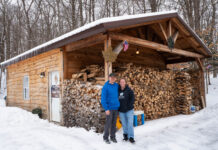SALEM, Ohio — The groundhog is a beloved animal each Feb. 2, when he emerges in Punxsutawney, Pennsylvania, to predict the coming of spring. But the rest of the year, he’s usually a nuisance.
The groundhog, woodchuck, whistle pig or whatever you call him, damages crops and gardens by eating fresh growth and by leaving a network of holes that can damage farm equipment, and potentially cause an accident.
Related:
The groundhog is also known to dig beside and beneath foundations, which can cause a host of structural issues, as well.
Each summer, farmers and rural landowners complain of the damaging effects of groundhogs, and seek to limit their numbers. Hunting is certainly one option — and in summer, a very popular option. But there are many other viable options, in addition to hunting.
1. Fencing. You probably won’t be able to build a fence around your whole farm, but gardens and food plots, and certain buildings are all game. Fences should be at least 3 feet high and made of heavy poultry wire or 2-inch woven mesh wire. To prevent groundhogs from burrowing under the fence, bury the lower edge 12 inches into the ground, with the lower 6 inches bent at an L-shaped angle, leading outward
Fences should be at least 3 feet above the ground, and as an additional measure, place an electric wire 4-5 inches above the ground, and about 4-5 inches outside the fence. When connected to a fence charger, the electric current will prevent climbing and burrowing, and will also help keep out other unwanted animals, like raccoons.
You can also bend the top 15 inches of wire fence outward at a 45 degree angle, which will prevent groundhogs from climbing over the fence.
2. Frightening the groundhogs. Scarecrows and other figures can provide temporary relief from groundhog damage. To make them seem more realistic, move them regularly and incorporate a high level of human activity in the susceptible area. You might also play a radio at certain hours of the day and night, to add some noise.
3. Fumigants and gas cartridges. Although more risky, certain fumigants and gas cartridges can also be used, but be mindful of the laws in your state and jurisdiction. Fumigants work by producing a toxic gas in the burrow system, but the gases are also toxic to other wildlife species. Follow the label instructions and use only on holes that are actively used by groundhogs.
Gas cartridges that emit carbon monoxide can also be used. Commercial gas cartridges are specially designed, cardboard cylinders that are filled with slow-burning chemicals.
The cartridges are ignited and placed into the burrow system, then sealed. As the gas burns, it produces gases that are lethal to groundhogs.
But be careful. Make sure that the burrows do not extend into wooden sheds, buildings or other nearby combustible material, because of the potential fire hazard. The cartridges are ignited by a fuse and will not explode if properly handled. The operator should also avoid breathing in the fumes.
4. Trapping. Groundhogs can be successfully trapped in both Ohio and Pennsylvania. Live traps should have a front of at least 10 by 10 inches, and be at least two feet long. Place the trap either at the burrow entrance, in major travel lanes, or at the site of damage. You can also place guide logs on both sides of the trap, to help funnel the groundhog into the trap. A trap should also be covered with dark canvas or grass, to conceal it.
For bait, consider using apple slices, carrots with tops, cantaloupe pieces, lettuce, cabbage or fresh peas. Replace the bait daily and remove any wilted pieces.
After the animal is trapped, it should be humanely destroyed or transported at least 10 miles away and released into suitable habitat, where it will not cause damage to another landowner.
5. Hunting. Groundhogs can be hunted in both states, but require a valid hunting license. Groundhogs can typically be hunted year-round, though spring and summer is most popular. In Ohio, groundhog hunting is closed during the seven-day deer gun season. Hunters also need the appropriate permission from landowners, and should be mindful of the full range of their weapon. Most rifle bullets can fly for a mile or more, depending on the caliber and the elevation from which they are shot.
6. Call a professional. Farmers and rural landowners can also call a qualified pest control provider, or someone else who is qualified to remove rodents. A local sportsman’s shop might be able to tell you of local hunters who hunt groundhogs. Various groups have been formed over the years, of hunters who specialize in rodent and predator control, including for hunting and trapping.
Animal welfare. For more information about how to properly euthanize groundhogs, visit the Ohio Veterinary Medical Association at www.ohiovma.org, or your local animal welfare organization.
(Source: Penn State Extension, Woodchuck control article; Ohio Department of Natural Resources, fact sheet on groundhogs.)











Dang-blasted “whistle-pigs!” Quite the nuisance and danger at my old place. I grew corn, bean, and oats and had a neighbor who bred Belgians for the local Amish. I took to shooting them, and I asked my neighbor why he didn’t do so.
“Well,” sighed John. “I used to shoot ’em regular like—but for every one I kilt, three more would come to his funeral!”
I learned later he had a few of the biggest and nastiest K9s around, who enjoyed catching and playing soccer with groundhog carcasses. Man–they cleaned ’em up right quick.
Great article. Don’t forget WV! http://www.wvdnr.gov/hunting/hunting_regs.shtm
Hi Chris, is there any type of a list of people who are interested in hunting groundhogs? If so, where can I get a copy. This would make my mother happier than the two bags of chocolate I got her for her birthday.
I would be happy to help you with your problem. I have been hunting ground hogs 30 years. Safe , accurate, respectable. 330 807 9107.
Susan,
I’m not sure of a current list, but I did run across a local organization that apparently organizes hunts. The North Central Ohio Varmint Express, out of Mansfield: http://www.ncovarmintexpress.com/frameset.htm
You could also ask around at places like Fin Feather Fur, or other local gunshops.
I would like a humane no kill method of ridding my groundhog problem.
Is this method very expensive and how do I find someone to do it ?
Thanks !
I am looking for someone who will remove groundhog without killing it or them.
I live in Mahoning County.
Could anyone help?
Also is it very expensive ?
Mary
Kill them, they are to pervasive. When you catch and release they end up on my property’s. They are not endangered stop being foolish at my cost.
does bubble gum kill ground hogs? Where can I buy in bulk?